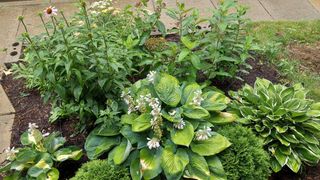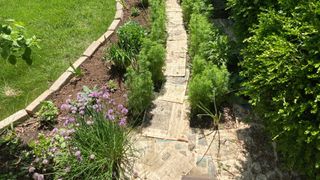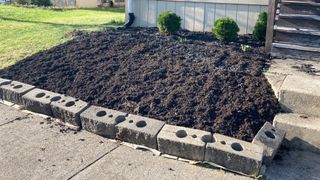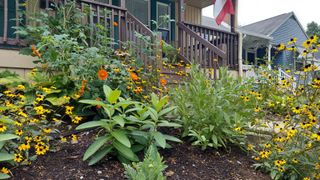Why Convert Your Lawn to a Garden With the No-Till Method
No-till or no-dig gardening is a sustainable method of gardening that, you guessed it, doesn’t require digging. That’s great news for gardeners and plants. No-till gardening is accessible and can help prevent back pain as well as improve your soil, which in turn helps plants.
It’s Good for Soil
Tilling can disrupt important organisms in the soil, bring buried weed seeds to the surface, and contribute to both soil erosion and compaction. The no-till method eliminates those problems. It helps build healthy soil and suppresses weeds. Think of a no-till garden as a compost pile in situ. It is composed of layers of newspaper or cardboard, compost, and mulch placed on top of the lawn you want to convert to garden. As the grass breaks down and decomposes, it adds nutrients to the soil of your new garden bed.
It’s Sustainable
No-till gardening, also known as sheet mulching, is sustainability at its finest. It doesn’t create waste–in fact it puts waste like newspaper and cardboard to good use–and it doesn’t require harmful chemicals like pesticides to kill grass for a garden bed.
How to Convert Your Lawn to a Garden
Converting your lawn to a garden is simple. Here’s how to do it in 5 easy steps:
1. Cut the Grass
Mow grass short and leave clippings in place. They will be the first layer of compost in your no-till garden. At this stage, you can also use an edger to create a clean break between the remaining lawn and your new garden bed, but this is optional.
2. Cover With Newspaper or Cardboard
Cover the desired area with 4-6 layers of newspaper or 1-2 layers of cardboard (make sure to remove any adhesive labels or tape). You can also use brown paper bags from the grocery. When killing grass with cardboard or paper, it’s essential to overlap the sheets by at least 2 inches (5 cm.) or else grass will grow through the cracks.
3. Water
Once you’ve covered the desired area, thoroughly wet the cardboard or papers with water. If you use newspaper or brown paper bags, it’s good to water as you cover the area. One gust of wind can send papers flying. Avoid stepping on the papers after watering. The wet newspapers are easy to tear and any holes you create will become weak points where grass can regrow.
4. Add Compost and Mulch
Spread at least 2 in. (5 cm.) of mature compost over the wet cardboard or paper and top with 2-4 in. (5-10 cm.) of mulch. If you don’t have compost that’s ready for use, spread 2 in. (5 cm.) of green material, like grass clippings or animal manure, then top with 2 in. (5 cm.) of brown material, like dry leaves or wood chips. Alternate layers of green and brown material until the bed measures about 18 in. (46 cm.) tall. This seems high, but by layering organic material you are essentially creating a compost pile. It will shrink as the material decomposes and forms the soil of your new garden bed. Top with 2-4 in. (5-10 cm.) of mulch and water again.
5. Plant
If you used layers of green and brown compost to build your no-till bed, you need to wait until the layers decompose before you plant. Create your garden bed in fall so it has all winter to decompose. Then in spring, your new bed will be ready to plant. If you created your no-till bed with mature compost, you’re ready to plant now! You can sprinkle seeds over the new bed to turn your lawn into a prairie garden. Perennials will take a year or two to bloom, but annuals will give you gorgeous flowers the first year. Want an instant facelift for your front yard? Choose your favorite plants from the nursery and plant directly into your new bed. This is the only digging you will need to do in your new no-dig front yard garden.




title: “How To Remove Grass For A Garden Using The No Till Method” ShowToc: true date: “2024-09-09” author: “Shawna Arnett”
Why Convert Your Lawn to a Garden With the No-Till Method
No-till or no-dig gardening is a sustainable method of gardening that, you guessed it, doesn’t require digging. That’s great news for gardeners and plants. No-till gardening is accessible and can help prevent back pain as well as improve your soil, which in turn helps plants.
It’s Good for Soil
Tilling can disrupt important organisms in the soil, bring buried weed seeds to the surface, and contribute to both soil erosion and compaction. The no-till method eliminates those problems. It helps build healthy soil and suppresses weeds. Think of a no-till garden as a compost pile in situ. It is composed of layers of newspaper or cardboard, compost, and mulch placed on top of the lawn you want to convert to garden. As the grass breaks down and decomposes, it adds nutrients to the soil of your new garden bed.
It’s Sustainable
No-till gardening, also known as sheet mulching, is sustainability at its finest. It doesn’t create waste–in fact it puts waste like newspaper and cardboard to good use–and it doesn’t require harmful chemicals like pesticides to kill grass for a garden bed.
How to Convert Your Lawn to a Garden
Converting your lawn to a garden is simple. Here’s how to do it in 5 easy steps:
1. Cut the Grass
Mow grass short and leave clippings in place. They will be the first layer of compost in your no-till garden. At this stage, you can also use an edger to create a clean break between the remaining lawn and your new garden bed, but this is optional.
2. Cover With Newspaper or Cardboard
Cover the desired area with 4-6 layers of newspaper or 1-2 layers of cardboard (make sure to remove any adhesive labels or tape). You can also use brown paper bags from the grocery. When killing grass with cardboard or paper, it’s essential to overlap the sheets by at least 2 inches (5 cm.) or else grass will grow through the cracks.
3. Water
Once you’ve covered the desired area, thoroughly wet the cardboard or papers with water. If you use newspaper or brown paper bags, it’s good to water as you cover the area. One gust of wind can send papers flying. Avoid stepping on the papers after watering. The wet newspapers are easy to tear and any holes you create will become weak points where grass can regrow.
4. Add Compost and Mulch
Spread at least 2 in. (5 cm.) of mature compost over the wet cardboard or paper and top with 2-4 in. (5-10 cm.) of mulch. If you don’t have compost that’s ready for use, spread 2 in. (5 cm.) of green material, like grass clippings or animal manure, then top with 2 in. (5 cm.) of brown material, like dry leaves or wood chips. Alternate layers of green and brown material until the bed measures about 18 in. (46 cm.) tall. This seems high, but by layering organic material you are essentially creating a compost pile. It will shrink as the material decomposes and forms the soil of your new garden bed. Top with 2-4 in. (5-10 cm.) of mulch and water again.
5. Plant
If you used layers of green and brown compost to build your no-till bed, you need to wait until the layers decompose before you plant. Create your garden bed in fall so it has all winter to decompose. Then in spring, your new bed will be ready to plant. If you created your no-till bed with mature compost, you’re ready to plant now! You can sprinkle seeds over the new bed to turn your lawn into a prairie garden. Perennials will take a year or two to bloom, but annuals will give you gorgeous flowers the first year. Want an instant facelift for your front yard? Choose your favorite plants from the nursery and plant directly into your new bed. This is the only digging you will need to do in your new no-dig front yard garden.




title: “How To Remove Grass For A Garden Using The No Till Method” ShowToc: true date: “2024-10-02” author: “Keith Jodon”
Why Convert Your Lawn to a Garden With the No-Till Method
No-till or no-dig gardening is a sustainable method of gardening that, you guessed it, doesn’t require digging. That’s great news for gardeners and plants. No-till gardening is accessible and can help prevent back pain as well as improve your soil, which in turn helps plants.
It’s Good for Soil
Tilling can disrupt important organisms in the soil, bring buried weed seeds to the surface, and contribute to both soil erosion and compaction. The no-till method eliminates those problems. It helps build healthy soil and suppresses weeds. Think of a no-till garden as a compost pile in situ. It is composed of layers of newspaper or cardboard, compost, and mulch placed on top of the lawn you want to convert to garden. As the grass breaks down and decomposes, it adds nutrients to the soil of your new garden bed.
It’s Sustainable
No-till gardening, also known as sheet mulching, is sustainability at its finest. It doesn’t create waste–in fact it puts waste like newspaper and cardboard to good use–and it doesn’t require harmful chemicals like pesticides to kill grass for a garden bed.
How to Convert Your Lawn to a Garden
Converting your lawn to a garden is simple. Here’s how to do it in 5 easy steps:
1. Cut the Grass
Mow grass short and leave clippings in place. They will be the first layer of compost in your no-till garden. At this stage, you can also use an edger to create a clean break between the remaining lawn and your new garden bed, but this is optional.
2. Cover With Newspaper or Cardboard
Cover the desired area with 4-6 layers of newspaper or 1-2 layers of cardboard (make sure to remove any adhesive labels or tape). You can also use brown paper bags from the grocery. When killing grass with cardboard or paper, it’s essential to overlap the sheets by at least 2 inches (5 cm.) or else grass will grow through the cracks.
3. Water
Once you’ve covered the desired area, thoroughly wet the cardboard or papers with water. If you use newspaper or brown paper bags, it’s good to water as you cover the area. One gust of wind can send papers flying. Avoid stepping on the papers after watering. The wet newspapers are easy to tear and any holes you create will become weak points where grass can regrow.
4. Add Compost and Mulch
Spread at least 2 in. (5 cm.) of mature compost over the wet cardboard or paper and top with 2-4 in. (5-10 cm.) of mulch. If you don’t have compost that’s ready for use, spread 2 in. (5 cm.) of green material, like grass clippings or animal manure, then top with 2 in. (5 cm.) of brown material, like dry leaves or wood chips. Alternate layers of green and brown material until the bed measures about 18 in. (46 cm.) tall. This seems high, but by layering organic material you are essentially creating a compost pile. It will shrink as the material decomposes and forms the soil of your new garden bed. Top with 2-4 in. (5-10 cm.) of mulch and water again.
5. Plant
If you used layers of green and brown compost to build your no-till bed, you need to wait until the layers decompose before you plant. Create your garden bed in fall so it has all winter to decompose. Then in spring, your new bed will be ready to plant. If you created your no-till bed with mature compost, you’re ready to plant now! You can sprinkle seeds over the new bed to turn your lawn into a prairie garden. Perennials will take a year or two to bloom, but annuals will give you gorgeous flowers the first year. Want an instant facelift for your front yard? Choose your favorite plants from the nursery and plant directly into your new bed. This is the only digging you will need to do in your new no-dig front yard garden.



